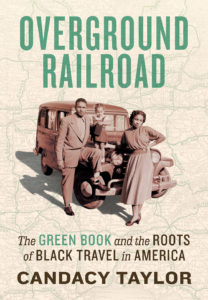Most of us have heard of the underground railroad, but have you ever heard of the overground railroad? I had not until the movie “The Green Book” came out. I didn’t see the movie, but hearing about it made me explore the premise and look up what exactly the Green Book was. As another example of white privilege, I had never considered what it might be like for black people to travel before the Civil Rights Act of 1964.
The Green Book was the answer to segregated travel conditions for African-Americans in the United States. It was published by a New York City postal worker named Victor Green from 1936 until 1966. Starting with places in New York City, and slowly expanding throughout the United States, the Green Book listed places that were safe for a black person to stay or eat while they were traveling.
 “Overground Railroad: The Green Book and Roots of Black Travel in America” details the history of the Green Book and of the systemic racism that made it necessary. During the 30 years of publication, black travelers were turned away from restaurants, hotels, and even gas stations owned by white people. Even finding a restroom could be dangerous. And it wasn’t only in the Jim Crow south. At least the rules were clear there. In the north, black people were just as likely to be refused service or amenities.
“Overground Railroad: The Green Book and Roots of Black Travel in America” details the history of the Green Book and of the systemic racism that made it necessary. During the 30 years of publication, black travelers were turned away from restaurants, hotels, and even gas stations owned by white people. Even finding a restroom could be dangerous. And it wasn’t only in the Jim Crow south. At least the rules were clear there. In the north, black people were just as likely to be refused service or amenities.
Candacy Taylor vigorously researched the “Overground Railroad” and visited many places listed in the Green Book. Here are a few of the stories in the book that really stuck out for me: in Columbus Ohio in the 1930’s, there was only one hotel that accepted black guests. Many black people relied on “guest houses” where black people rented a room.

Black men who owned new cars would carry a chauffer’s cap in the car. If they got stopped by a police officer, they would put on the cap and claim they were driving for someone. Otherwise they were in danger of being beaten or accused of stealing the car.
Because black people were routinely denied loans solely based on their color, most of them couldn’t own their own businesses. They were most likely to restaurants when they did own businesses. But if black businesses got too successful, especially if they attracted white customers, they were visited by police officers, white mobs, or the Klan. Any that defied the pressure to only serve blacks were often burned down or the owners beat up. Many black business owners were lynched. White business owners who served black customers were subject to the same kind of pressure.
One more example: in Alabama in the 1930’s, it was illegal for a black person in a car to pass a white person. Black people could be thrown in jail for passing another car on the road.
These examples made me angry and made me thankful for the Civil Rights Act of 1964 which made these actions illegal. But I also recognize that we still have a very long way to go before black people receive equal treatment from white people.
“Overground Railroad” is an excellent book for opening your eyes to systemic racism. Some things are better and some things are not. For black people, getting behind the wheel of a car can still be unnecessarily dangerous.
